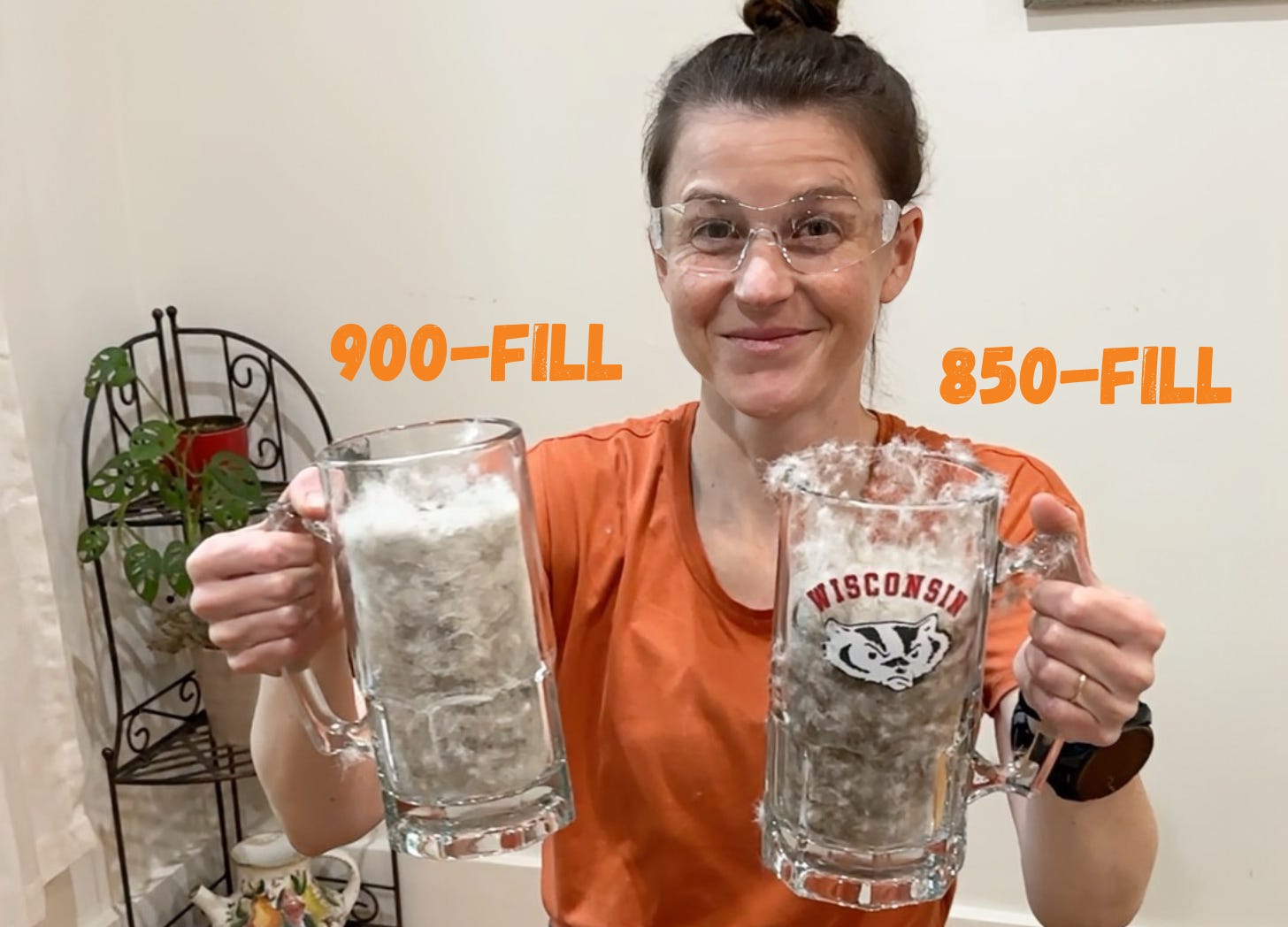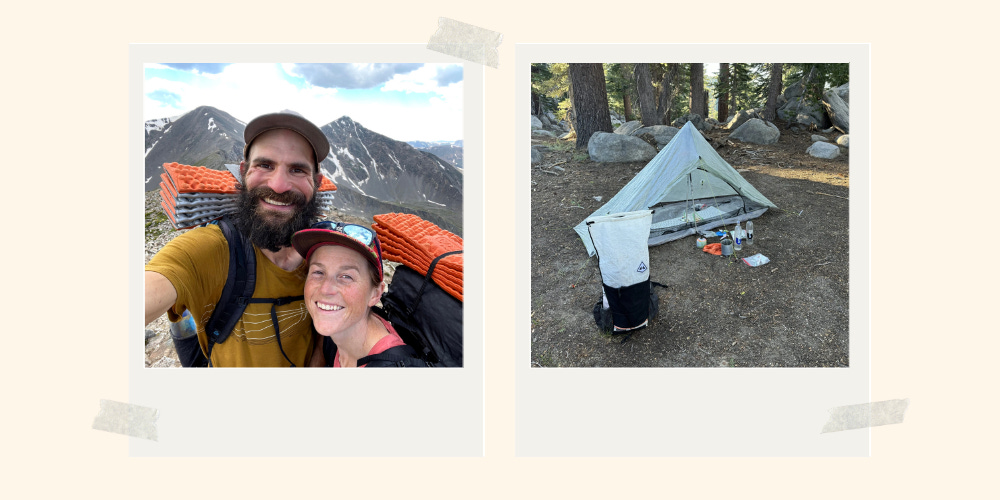The Truth About Down Ratings
Let’s break down what you need to know about staying warm—and it’s probably not what you think!
When we were getting ready to venture out on the Pacific Crest Trail for our first big thru-hike, we both got brand new puffy jackets. They were warm and comfy, but during the four and a half months we spent out there, we learned how important it is to have light-weight gear when you have to carry it all day, every day. For our next thruhike on the Continental Divide Trail, we upgraded those jackets to models with higher-rated down. They were just as fluffy and comfortable, but a whole lot lighter!
That said, despite being made of higher-quality down, they were not any warmer. Something confusing about down ratings is that it doesn’t necessarily tell you anything at all about warmth. We have jackets with very high “fill-power” ratings that are terrible at keeping us warm, and jackets with the same ratings that are toasty. We have jackets with low fill ratings that are super warm, and others that are not. So, what’s up with this?
Let’s get into it on why down ratings matter, what the rating actually means, and when you may or may not want to factor fill-power into your gear decisions.
What is down and why its rating matters
Down is plumage from birds (usually geese) that’s found beneath their feathers. It’s there to give them insulation and warmth, just like it does for us when it’s put into a jacket or sleeping bag. A fill-power rating indicates how much insulation a given quantity of down (by weight) will provide.
But the amount of insulation in a piece of equipment (by volume) is what provides warmth. So, down ratings don’t tell you how warm the equipment is. They only give an indication of warmth relative to weight, or weight relative to warmth.
For a piece of equipment you’ll be using around town and never stuffing into a small pack to carry on your back, ratings don’t matter. For a piece of gear you have to carry, ratings matter a lot.
Let’s think about two examples:
Fixed warmth: If you have two almost identical down jackets that keep you warm down to 32F (0C), but one is stuffed with 700-fill down and the other with 1,000-fill, the jacket with 1,000-fill will be lighter, because it takes less 1,000-fill down to insulate.
Fixed weight: If you have two almost identical down jackets that are the same weight, but one is stuffed with 700-fill down and the other with 1,000-fill, the jacket with 1,000-fill down will keep you warm in colder temperatures, because the down inside can expand to fill a larger volume and hence provide more insulation.
Puffy Jackets
Choosing the right puffy jacket for your needs can be confusing, especially if you’re shopping online. Usually, the most important factor is warmth. But jackets are almost never rated for warmth.
Manufacturers will proudly state and market a jacket based on the fill power of the jacket’s down. They’ll almost never market how much down is in the jacket, and beyond that, how the down is distributed throughout.
In our experience, the only way to really understand how warm a jacket will be is to try it out in the elements, or to talk to people who have. If weight is an important consideration (e.g. if you’ll be using the jacket backpacking), it’s a good idea to get high fill-power down, because that minimizes weight relative to warmth. Sadly, getting hands-on experience with a jacket is the only way to know for sure if it’s warm enough.
Sleeping Bags
Choosing a sleeping bag can be a much more straightforward experience. Sleeping bags are almost always rated for warmth based on a standardized testing procedure that’s used across manufacturers. For the most part, a 20-degree sleeping bag should provide the same warmth regardless of its down rating, total weight, or manufacturer, because the temperature rating is based on tests that factor all of that in.
That doesn’t mean a specific temperature rating will be equally comfortable for all people at the rated temperature. We’re all a little different, with some people “sleeping warm” and others “sleeping cold”, but you can at least use the temperature rating of sleeping bags to comparison shop across other factors that matter, like weight, price, features, etc.
For both of us, 20°F-rated bags (Tim’s bag / Renee’s bag) are pretty good for all-around use on trips in the mountains in early through late summer, but we use bags rated for colder temperatures in cold seasons and bags rated for warmer temperatures for non-mountain hikes in the summer. When shopping, we recommend choosing the temperature rating you want, and then optimizing for weight, price, etc.




How down is rated
For the geeky ones among us, here’s how down is actually rated. The rating is the volume, in cubic inches, that exactly 30g of down will fill (with a small weight placed on top). Let’s marvel for a moment at how ridiculous that rating system is – the mass is specified according to the metric system, but the volume is imperial. Not sure who thought that was a good idea!
So, 30g of 700-fill down will fill exactly 700 cubic inches (i.e. the volume of about 11 Smartwater bottles), and 30g of 1,000-fill down will fill exactly 1,000 cubic inches (i.e. the volume of about 16 Smartwater bottles). We just did a test with 850-fill and 950-fill down that Enlightened Equipment was kind enough to send us. This is what they use for their famous quilts, which are probably the most popular sleeping bag/quilt on long-distance trails like the PCT and CDT. Sure enough, when we weighed out precisely 5g of each type of down, the 950-fill down occupied more space than the 850-fill down.
Curious about our favorite sleeping bags? Read Renee’s Feathered Friends Egret Nano 20°F review on our website.
Want to learn more about down? Check out our latest video and our conversation in our Substack members-only chat.










